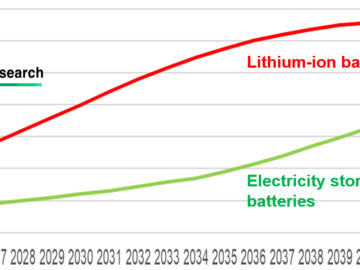The Megatrend to Energy Storage Without Batteries
Lithium-ion batteries are not immune from the “S curve”. Their sales will level off within 20 years. One reason is the arrival of better batteries but a bigger impact is coming from failure of any battery to meet certain major new needs for energy storage. This is described in the new 441-page Zhar Research report, “Battery-free electrical energy storage and storage elimination milliWh-GWh: markets, technologies 2024-2044”. 225 companies are mentioned in this context. See 31 forecast lines 2024-2044.
Future electricity grids increasingly escape from batteries
The largest new, emerging requirement comes from most of the world’s electricity grids adopting much more wind and solar power. This usually delivers the lowest cost of electricity but such power is very intermittent and it cannot follow changes in demand. A grid with only 20% wind/ solar can manage with batteries because storing the electricity for a few hours covers most of its requirements. As grids rise to around 50% wind/ solar, it becomes important to compensate solar dead at night and wind dead for similar times. That is why we already see some grids already adopting 12-hour storage where lithium-ion batteries are uneconomic. They leak energy too much and are too expensive so other batteries are used. Also used for this is storage without batteries such as pumping water up mountains (“pumped hydro”) or compressing gases then turning them back into electricity later, when needed.
Grids using mostly wind and solar power are arriving
However, many grids now plan 70-100% wind/ solar power and that makes sense only with average storage one or two months and preferably some storage from summer to winter. Winter power from solar panels is typically only one fifth of that in summer. Wind can be dead for months. No battery can achieve one month or more of storage economically. Storage without batteries, including extra options such as lifting weights or making liquid air are beginning to be used. Making hydrogen (then back to electricity) is also proposed for this. Battery-free technology replaces batteries because the needs change to where batteries are useless. Other benefits of the battery-free storage include life of up to 100 years and typically no toxic or scarce materials. Indeed, most of the non-battery options can provide both short-term and long-term grid storage.
Huge increase in needs for pulsed electricity
Another change in demand increasingly leaves batteries as useless. It is the many new forms of engineering that require pulses of power in and out. Examples are the new military laser pistols and large stationary laser cannon also planned on ships. There are even new weapons that shoot out electromagnetic energy that disables all electronics on an aircraft. Within 20 years we may also see the first thermonuclear electricity generation based on such pulsed storage. Meanwhile, Evans fit-and-forget, tantalum capacitor-supercapacitors are already used by most Tier One defense and aerospace contractors. Applications include laser targeting, communications modules, controls, cockpit displays, phased array radars and control of firing of weapons – all growth markets.
The medical sector uses electrical pulses in MRI body scanners but now many more medical devices with similar needs for pulses are arriving, including robotic treatments. The trends to fit-and-forget devices and very fast charging also make us escape from batteries. An example is robot vehicles in factories. The new hydrogen high-speed trains in China cannot provide the fast acceleration and capture of braking energy with batteries. In all these cases supercapacitors or their variants are chosen. The supercapacitor variants are mostly intermediate in technology between conventional capacitors and supercapacitors or between supercapacitors and batteries.
Here comes a $230 billion market for you
The current market for battery alternatives mainly consists of pumped hydro for grids at tens of billions of dollars yearly and supercapacitors at the billion-dollar level. That is only a beginning. Indeed, Zhar Research finds that the battery-free (storage without batteries) market will exceed $230 billion in 2044 with growth rate accelerating throughout the coming years. It reveals your enormous opportunities to sell materials and hardware into this new business. In addition the report has coverage of the move to eliminate electrical storage altogether. For example, a later stage of the planned 6G Communications may power devices from the signal beam. However, most of the Zhar Research report “Battery-free electrical energy storage and storage elimination milliWh-GWh: markets, technologies 2024-2044” analyses the huge opportunity for alternatives to batteries.
Press release distributed by Pressat on behalf of Zhar Research , on Tuesday 24 October, 2023. For more information subscribe and follow https://pressat.co.uk/
Lithium-Ion Batteries Batteryfree Batteryless Storage Microgrids Electricity Emerging Technology Solar Wind Energy Medical MRI Capacitor Business & Finance Computing & Telecoms Consumer Technology Education & Human Resources Health Manufacturing, Engineering & Energy
Published By

anastasiams@zharresearch.com
https://www.zharresearch.com/
Dr Peter Harrop
peterharrop@zharresearch.com
Visit Newsroom
You just read:
The Megatrend to Energy Storage Without Batteries
News from this source:


